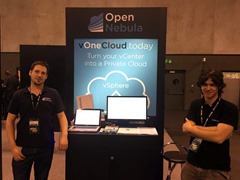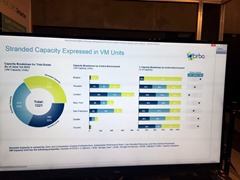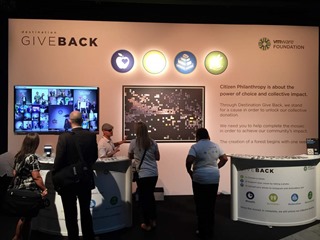Cloud Field Day 2, part of the Tech Field Day family of events is happening in San Francisco and Silicon Valley, from 26-28 July and I’m super excited to be invited as a delegate.
We are hearing from a number of companies about how they cloud!
 Nirmata is a new Tech Field Day presenter and a company that I haven’t heard of before. Nirmata means architect in Indo-Aryan languages and its mission is to “enable enterprises to innovate faster, by transforming how software is deployed and operated.”
Nirmata is a new Tech Field Day presenter and a company that I haven’t heard of before. Nirmata means architect in Indo-Aryan languages and its mission is to “enable enterprises to innovate faster, by transforming how software is deployed and operated.”
It seems Nirmata has been running for just short of 4 years and founded by a team who are interested in using DevOps to fully automate the management of applications across clouds. Co-founder Jim Bugwadia came from Cisco and isn’t just the hand waving inspirational, strategy management type but likes to still keep his developer hands busy saying he codes in Go, Java, and Javascript. Other co-founders: Damien Toledo was from NetScout and Ritesh Patel was from Brocade.
Nirmata runs a cloud service to fully automate the management of containerised applications across public and private clouds as well as connected devices. I’m not sure what the connected devices refers to though.
Enterprise are adopting more and more DevOps as well as deploying new applications in containers. They are also wanting to potentially V2C (VM to Container, the new version of P2V, physical to virtual) existing applications to take advantage of some container functionality such as a standardised packaging format and simpler deploys. Nirmata says it can plumb seamlessly into a CI/CD pipeline and give enterprises the security segregation and auditing they need.
There is built in service discovery and what seems could be a sort of API gateway which they call a service gateway. This seems a little more advanced than just network routing to get requests to the right containers, keen to understand more.
Read more…
Since VMworld there’s been a huge amount of news about EMC(Dell)+Virtustream_vCloud Air. Basically EMC(Dell) will be consolidating most of its cloud assets under Virtustream which will be spun out as a separate company with EMC(Dell) owning 50% and VMware the other half. I’ll go into more details of the spin out but first here’s what I learnt speaking to them at the show.
Adding some more colour to the highlights from my VMworld Europe 2015 coverage:
I had a chat to Andy Sugden from Virtustream who EMC acquired recently. I had some misconceptions about Virtustream and how they competed with vCloud Air. Virtustream basically has software called xStream which big enterprises (on or off-prem) or service providers use to create managed instances of SAP and some other big applications. This takes a lot of the complexity away from managing these apps and provides a secure wrapper around the whole app up and down the entire stack so it can work in a multi-tenant environment and ticks all the security and compliance boxes. You can also create and manage performance and availability SLAs using the software. IBM use it (mmm, not for much longer I guess!). I can certainly see integration with vCloud Air by bringing some more of that secure multi-tenancy to vCloud Air but the big apps Virtustream manage aren’t the first applications people are moving to the public cloud so its normally a managed cloud offering, it was certainly interesting to get a better understanding.
What’s new and what does it mean?
Read more…
Adding some more colour to the highlights from my VMworld Europe 2015 coverage:
OpenNebula
 I spent quiet a bit of time in the Solutions Exchange and made a point of going through the New Innovators section. I found OpenNebula which seems a very simple private cloud enabler which piqued my interest after worrying about the complexity of vRealize Automation and vCloud Director for private cloud. It seems a very simple solution, download an .OVA, suck in your templates and then provide a portal to clients to be able to deploy cloud like those templates, very simple just what many companies need. I believe it is even open source with an Apache license.
I spent quiet a bit of time in the Solutions Exchange and made a point of going through the New Innovators section. I found OpenNebula which seems a very simple private cloud enabler which piqued my interest after worrying about the complexity of vRealize Automation and vCloud Director for private cloud. It seems a very simple solution, download an .OVA, suck in your templates and then provide a portal to clients to be able to deploy cloud like those templates, very simple just what many companies need. I believe it is even open source with an Apache license.
Open Nebula says it is an enterprise-ready turnkey solution for deploying private clouds, You can use KVM, Xen or ESXi as your hypervisor and can also layer it over vCenter to provide a multi-tenant private cloud.
As a consumer you can use AWS EC2 and EBS APIs, it has a marketplace of appliances ready to be run in OpenNebula, has chargeback/accounting, auditing, RBAC, quotas, etc. a pretty comprehensive list of features.
Community support is available or you can pay for commercial support straight from the developers.
I will certainly be downloading their software and having a look.
Adding some more colour to the highlights from my VMworld Europe 2015 coverage:
Cirba
 I spoke to Bill Chatzidakis from Cirba as I’ll be visiting them soon on a Tech Field Day event. He went through what Cirba is (been around 10+years in different incarnations!). It’s a software product which is all about capacity planning and right sizing your environment, targeted at enterprises and service providers to manage big numbers of VMs. It has nifty graphs for telling you which clusters are over or under subscribed and collects a month’s worth of data to work out best placement of VMs. This is DRS on steroids, an approach VMTurbo is also tackling. You can create models for what your VMs require in terms of resources, availability, security and then Cirba can tell you what clusters you have available (vSPhere, Hyper-V, KVM) and where best to host these. You can use Cirba integration with vRealize Automation so as part of the approval process it will reserve future capacity in Cirba for the VMs. Once approved, Cirba talks back to vRealize Automation for the deployment. It uses multiple metrics so can push together VMs or push them apart using many measurements as well as what it thinks the VM will be doing in the future based on previous history. Cirba says it is therefore far more proavtively responsive rather than reactive like DRS.
I spoke to Bill Chatzidakis from Cirba as I’ll be visiting them soon on a Tech Field Day event. He went through what Cirba is (been around 10+years in different incarnations!). It’s a software product which is all about capacity planning and right sizing your environment, targeted at enterprises and service providers to manage big numbers of VMs. It has nifty graphs for telling you which clusters are over or under subscribed and collects a month’s worth of data to work out best placement of VMs. This is DRS on steroids, an approach VMTurbo is also tackling. You can create models for what your VMs require in terms of resources, availability, security and then Cirba can tell you what clusters you have available (vSPhere, Hyper-V, KVM) and where best to host these. You can use Cirba integration with vRealize Automation so as part of the approval process it will reserve future capacity in Cirba for the VMs. Once approved, Cirba talks back to vRealize Automation for the deployment. It uses multiple metrics so can push together VMs or push them apart using many measurements as well as what it thinks the VM will be doing in the future based on previous history. Cirba says it is therefore far more proavtively responsive rather than reactive like DRS.
Cloud placement is going to be an interesting future conundrum: what cloud, what location, what network, what price, what risk, what availability?
This was a good primer before I get to hear more in a few weeks.
Adding some more colour to the highlights from my VMworld Europe 2015 coverage:
I suppose you could say VMworld for most attendees (partners were having their 1st day yesterday) kicked off with the General Sessions.
The keynote had fair amount of content common to the VMworld US keynote with some local changed information.
There was no point live blogging as a lot of the content has been covered previously so well by Scott Lowe.
Jean-Pierre Brulard, SVP and GM for EMEA started the show off.
10k attendees, 96 countries, 2.3k VMUG members.
He mentioned Destination Give back which is a VMware Foundation charity programme focussed on children, education , health, environment.





Read more…
Adding some more colour to the highlights from my VMworld Europe 2015 coverage:
Session was led by Chris Crafford, a Practice Manager, VMware
This again was a high level overview of the technologies available and went through what microservice are, the 12 factor apps I mentioned in the lab I did and why they are better for cloud environments. Microservices only manage the data they care about, are accessed only via the service, there are no shared libraries.
Chris mentioned an interesting thing I hadn’t thought of for the definition. Microservices need to be automatically deployed to make them true microservices, its not good enough to just have services that are micro.
Chris went through one of the major tenets of microservices which is all about failure management, assume failure and have an architecture that mitigates the impact of the faults, errors and failures at runtime.
Then Chris went on to talk about migrating legacy applications which must be done as an evolutionary approach. Choose the most business urgent to break out first. Use containers for this new bit and leverage best practices for CI/CD, automating all the steps. Learn and improve and then repeat for the next service that has been prioritised.
Another thing Chris mentioned was some deployments use one microservice per container but this makes management more challenging so consider a business role mapped to a container model instead.
The short session ended with a vCloud Air commercial, VMware funnily enough says it is the ideal target for migration of legacy applications particularly with the recent announcements with layer 2 networking between your data center and vCloud Air and container security with NSX.
The future of vCloud Air and how it will integrate with EMCs recent aquisition of Virtustream now becomes very interesting as vCloud Air is being moved out of VMware direct management and folded directly into Virtustream. Who knows what the future holds.

I previewed VMworld San Francisco in my post: VMworld: Juggling and jousting, VMware’s battles for the future where I initially highlighted the recent people changes at VMware as well as the rough and tumble world VMware lives in while marketing and selling storage and networking. I also spent some time going though the changing face of application development which I’ll expand on in this post.
It’s different
VMworld Europe is the smaller sibling to the exuberant big ‘ol US VMworld that always seems to pave the way. 8000 attendees rather than 23000 certainly makes a difference although calling it more intimate would be taking it a bit far. All the big announcements and strategy crystal ball gazing is mostly done by VMworld US so Europe has historically been left with the hand me downs in terms of announcements. The focus for VMware is to re-use its US content in Europe 2 months later without it feeling stale and introduce just enough new information and provide the networking opportunities to make people spend the money to go.
Read more…

Many companies trying to take advantage of cloud computing are embracing the moniker of the “Software Defined Data Center” as one way to understand and communicate the benefits of moving towards an infrastructure resource utility model. VMware has taken on the term SDDC to mean doing everything in your data center with software and not requiring any custom hardware. Other companies sell “software-defined” products which do require particular hardware for various reasons but the functionality can be programmatically controlled and requested all in software. Whether your definition of “software-defined” mandates hardware or not the general premise (nothing to do with premises!) is being able to deliver and scale IT resources programmatically.
 This is great but I think SDDC is just a stepping stone to what we are really trying to achieve which is the “Policy Defined Data Center”.
This is great but I think SDDC is just a stepping stone to what we are really trying to achieve which is the “Policy Defined Data Center”.
Once you can deliver IT resources in software, the next step is ensuring those IT resources are following your business rules and processes, what you would probably call business intelligence policy enforcement. These are the things that your business asks of IT partly for regulatory reasons like data retention and storing credit cards securely but also encompasses a huge amount of what you do in IT.
Here are a few examples of what kinds of policies may you have:
- Users need to change their passwords every 30 days.
- Local admin access to servers is strictly controlled by AD groups.
- Developers cannot have access to production systems.
- You can only RDP to servers over a management connection.
- Critical services need to be replicated to a DR site, some synchronously, others not.
- Production servers need to get priority over test and development servers.
- Web server connections need to be secured with SSL.
- SQL Server storage needs to have higher priority over say print servers.
- Oracle VMs need to run on particular hosts for licensing considerations.
- Load balanced web servers need to sit in different blade chassis in different racks.
- Your trading application needs to have maximum x latency and minimum y IOPS
- Your widget application needs to be recoverable within an hour and no be more than 2 hours out of date.
- Your credit card database storage needs to be encrypted
- All production servers need to be backed up, some need to be kept for 7 years.
Read more…
Series:
Today was the final day of HP Discover.
HP Software
There was meant to be a blogger Coffee Talk this morning from HP Software but I was the only one to attend. The HP Software division isn’t in my normal area of interest so was an opportunity to find out what its all about. Instead of having a group blogger chat, I spent an interesting hour with Paul Muller, VP of Strategic Marketing & Chief Evangelist who is a passionate, blunt, straight talking Aussie (the best kind!). If like me you are not aware of HPs software portfolio, it encompasses tools for Business Service Management, Network Management and Automation, Application Lifecycle Management, Quality and Performance Validation, Security, Automation and Cloud Management, Information Optimization, Big Data Analytics, IT Service Management and Mobile Application Development.
 That’s quite a broad portfolio. Products within these group I had heard of were LoadRunner, Fortify, TippingPoint, Arcsight, Cloud Service Automation, Autonomy but there are so many more. Paul explained how some integrate such as security with Big Data analysis so you can search all information leaving your company network and find out whether any sensitive information is escaping, not just looking for a “confidential” tag on a doc but deep inspection along with machine learning that can correlate patterns across multiple information sources.
That’s quite a broad portfolio. Products within these group I had heard of were LoadRunner, Fortify, TippingPoint, Arcsight, Cloud Service Automation, Autonomy but there are so many more. Paul explained how some integrate such as security with Big Data analysis so you can search all information leaving your company network and find out whether any sensitive information is escaping, not just looking for a “confidential” tag on a doc but deep inspection along with machine learning that can correlate patterns across multiple information sources.
Autonomy?
Read more…
 VMware has released what at first looks like a minor update to their PowerShell snapin, PowerCLI to version 5.01. Although just a .01 release which brings the usual changes and bug fixes which are listed here, the big news is that VMware has added a whole bunch of cmdlets for managing vCloud Director.
VMware has released what at first looks like a minor update to their PowerShell snapin, PowerCLI to version 5.01. Although just a .01 release which brings the usual changes and bug fixes which are listed here, the big news is that VMware has added a whole bunch of cmdlets for managing vCloud Director.
A whole new snapin has been created called VMware.VimAutomation.Cloud and this initial release focuses more on the reporting side, so being able to retrieve information from vCD rather than setting things but also does have cmdlets for importing VMs, Templates and .OVFs from vSphere into your vCD environment. This is a great step forward as cloud computing relies so much on automation and having PowerCLI also available means you have so many more options to tie together your automation workflows.
Read more…
 Nirmata is a new Tech Field Day presenter and a company that I haven’t heard of before. Nirmata means architect in Indo-Aryan languages and its mission is to “enable enterprises to innovate faster, by transforming how software is deployed and operated.”
Nirmata is a new Tech Field Day presenter and a company that I haven’t heard of before. Nirmata means architect in Indo-Aryan languages and its mission is to “enable enterprises to innovate faster, by transforming how software is deployed and operated.”








 This is great but I think SDDC is just a stepping stone to what we are really trying to achieve which is the “Policy Defined Data Center”.
This is great but I think SDDC is just a stepping stone to what we are really trying to achieve which is the “Policy Defined Data Center”.


Recent Comments